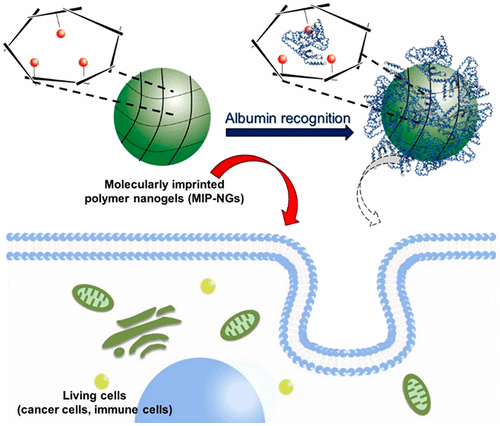当前位置:
X-MOL 学术
›
ACS Appl. Polym. Mater.
›
论文详情
Our official English website, www.x-mol.net, welcomes your
feedback! (Note: you will need to create a separate account there.)
Cellular Interaction Regulation by Protein Corona Control of Molecularly Imprinted Polymer Nanogels Using Intrinsic Proteins
ACS Applied Polymer Materials ( IF 4.4 ) Pub Date : 2020-03-16 , DOI: 10.1021/acsapm.9b01149 Natsuki Hayakawa 1 , Takuya Yamada 1 , Yukiya Kitayama 1 , Toshifumi Takeuchi 1
ACS Applied Polymer Materials ( IF 4.4 ) Pub Date : 2020-03-16 , DOI: 10.1021/acsapm.9b01149 Natsuki Hayakawa 1 , Takuya Yamada 1 , Yukiya Kitayama 1 , Toshifumi Takeuchi 1
Affiliation

|
Nanomaterials have a great potential for use in various biorelated applications such as drug delivery systems and in vivo imaging; understanding nanoparticle–cell interactions is an important requisite for these applications. Herein, the nanoparticle–cell interactions, including the cellular uptake mechanism, were investigated in detail using polymer nanogels possessing molecular recognition ability (molecularly imprinted polymer nanogels: MIP-NGs) capable of protein corona regulation via albumin recognition and using refractory cancer cell lines and an immune-related cell line. Albumin recognition in the MIP-NGs further increased the albumin-dependent inhibition of cellular uptake of the nanogels, including uptake by cancer cells and macrophages. Cellular uptake was inhibited more efficiently in MIP-NGs than in the reference nonimprinted polymer nanogels without albumin recognition cavities. In the presence of serum albumin, MIP-NGs did not cause a significant upregulation of inflammatory reactions as measured by cytokine secretion by macrophages. To the best of our knowledge, our study is the first to use molecular recognition of albumin in nanogels to regulate the protein corona and in turn control cellular interactions. Our results provide strong evidence that MIP-NGs could utilize human serum albumin in the formation of a protein corona to avoid immune responses. We hope our results can provide important insights that translate into biomedical applications of nanomaterials.
中文翻译:

通过蛋白质电晕控制分子印迹聚合物纳米凝胶使用内在蛋白的细胞相互作用调节。
纳米材料具有巨大的潜力,可用于各种生物相关的应用,例如药物输送系统和体内成像 了解纳米颗粒与细胞之间的相互作用是这些应用的重要前提。在本文中,使用具有分子识别能力的聚合物纳米凝胶(分子印迹聚合物纳米凝胶:MIP-NGs)通过白蛋白识别和蛋白质难治性电晕调节,并使用难治性癌细胞系,详细研究了纳米颗粒与细胞之间的相互作用,包括细胞摄取机制。免疫相关的细胞系。MIP-NG中的白蛋白识别进一步增加了白蛋白依赖性的纳米凝胶对细胞摄取的抑制,包括癌细胞和巨噬细胞的摄取。与没有白蛋白识别腔的参考非印迹聚合物纳米凝胶相比,MIP-NGs更有效地抑制了细胞摄取。在血清白蛋白存在的情况下,如巨噬细胞分泌的细胞因子所测量,MIP-NGs不会引起炎症反应的显着上调。据我们所知,我们的研究是第一个使用纳米凝胶中白蛋白的分子识别来调节蛋白电晕并进而控制细胞相互作用的研究。我们的结果提供了有力的证据,表明MIP-NGs可以利用人血清白蛋白形成蛋白质电晕以避免免疫反应。我们希望我们的结果能够提供重要的见解,并将其转化为纳米材料的生物医学应用。我们的结果提供了有力的证据,表明MIP-NGs可以利用人血清白蛋白形成蛋白质电晕以避免免疫反应。我们希望我们的结果能够提供重要的见解,并将其转化为纳米材料的生物医学应用。我们的结果提供了有力的证据,表明MIP-NGs可以利用人血清白蛋白形成蛋白质电晕以避免免疫反应。我们希望我们的结果能够提供重要的见解,并将其转化为纳米材料的生物医学应用。
更新日期:2020-04-23
中文翻译:

通过蛋白质电晕控制分子印迹聚合物纳米凝胶使用内在蛋白的细胞相互作用调节。
纳米材料具有巨大的潜力,可用于各种生物相关的应用,例如药物输送系统和体内成像 了解纳米颗粒与细胞之间的相互作用是这些应用的重要前提。在本文中,使用具有分子识别能力的聚合物纳米凝胶(分子印迹聚合物纳米凝胶:MIP-NGs)通过白蛋白识别和蛋白质难治性电晕调节,并使用难治性癌细胞系,详细研究了纳米颗粒与细胞之间的相互作用,包括细胞摄取机制。免疫相关的细胞系。MIP-NG中的白蛋白识别进一步增加了白蛋白依赖性的纳米凝胶对细胞摄取的抑制,包括癌细胞和巨噬细胞的摄取。与没有白蛋白识别腔的参考非印迹聚合物纳米凝胶相比,MIP-NGs更有效地抑制了细胞摄取。在血清白蛋白存在的情况下,如巨噬细胞分泌的细胞因子所测量,MIP-NGs不会引起炎症反应的显着上调。据我们所知,我们的研究是第一个使用纳米凝胶中白蛋白的分子识别来调节蛋白电晕并进而控制细胞相互作用的研究。我们的结果提供了有力的证据,表明MIP-NGs可以利用人血清白蛋白形成蛋白质电晕以避免免疫反应。我们希望我们的结果能够提供重要的见解,并将其转化为纳米材料的生物医学应用。我们的结果提供了有力的证据,表明MIP-NGs可以利用人血清白蛋白形成蛋白质电晕以避免免疫反应。我们希望我们的结果能够提供重要的见解,并将其转化为纳米材料的生物医学应用。我们的结果提供了有力的证据,表明MIP-NGs可以利用人血清白蛋白形成蛋白质电晕以避免免疫反应。我们希望我们的结果能够提供重要的见解,并将其转化为纳米材料的生物医学应用。





















































 京公网安备 11010802027423号
京公网安备 11010802027423号